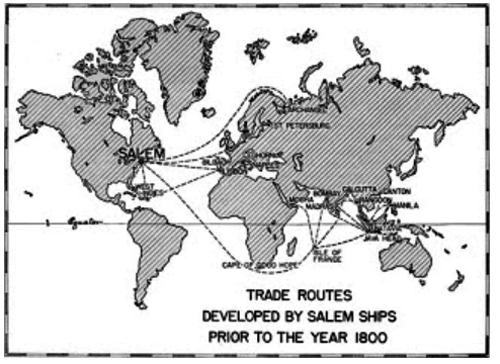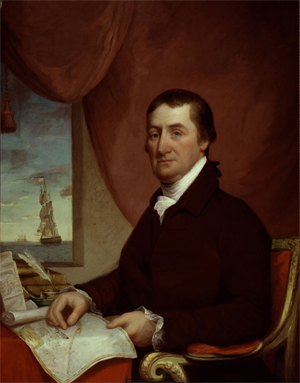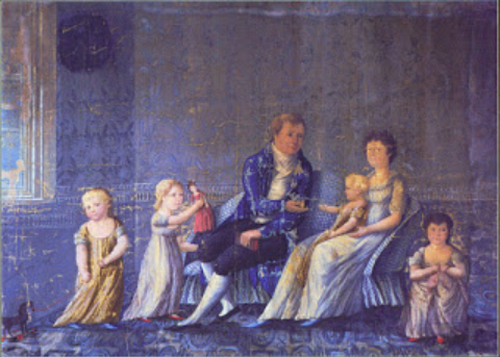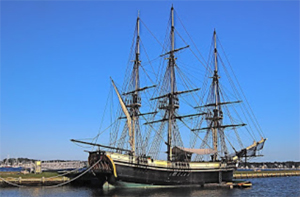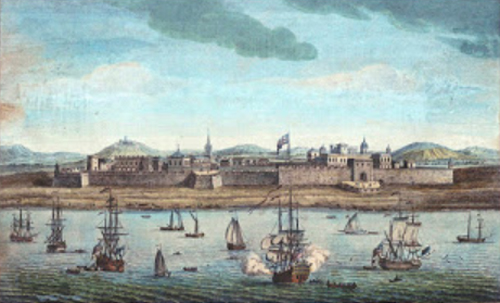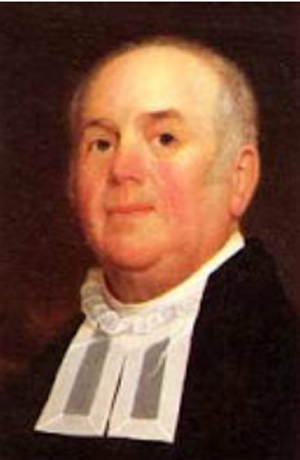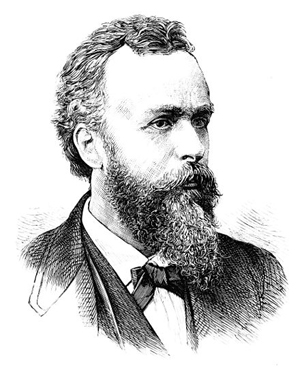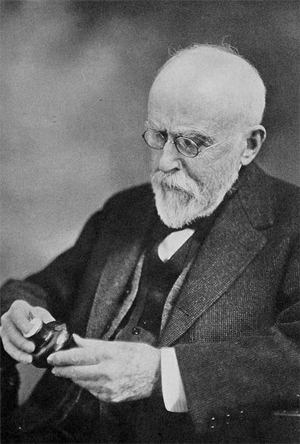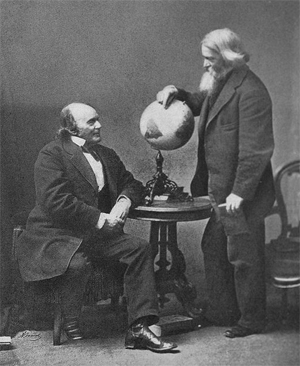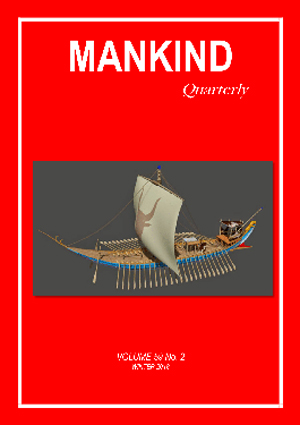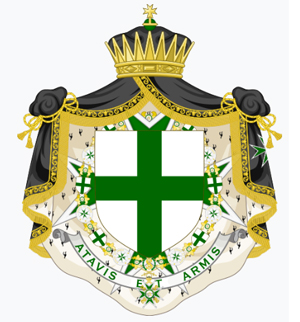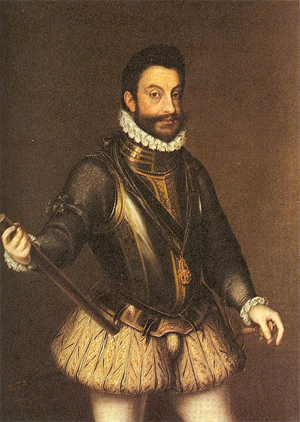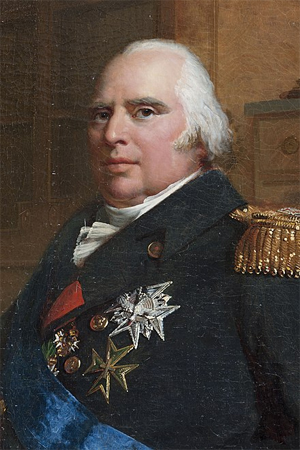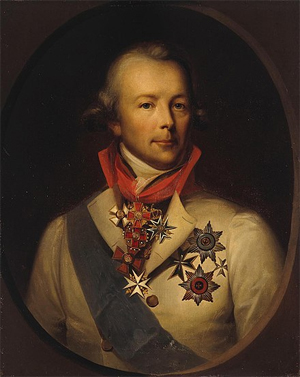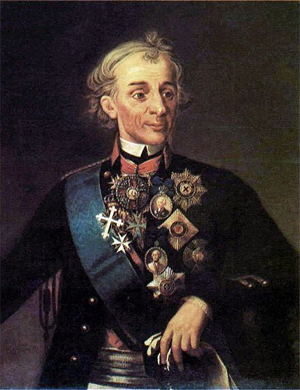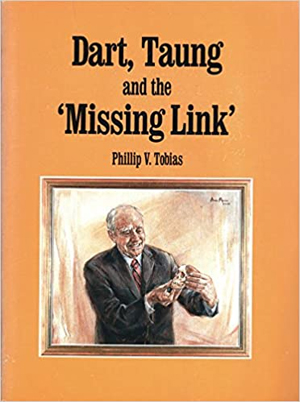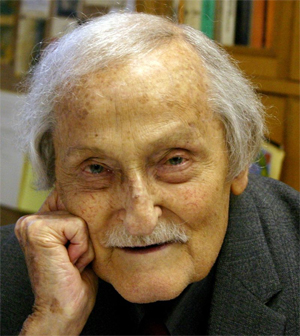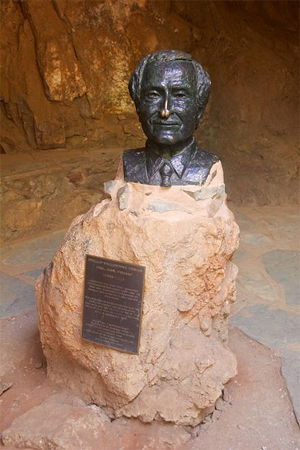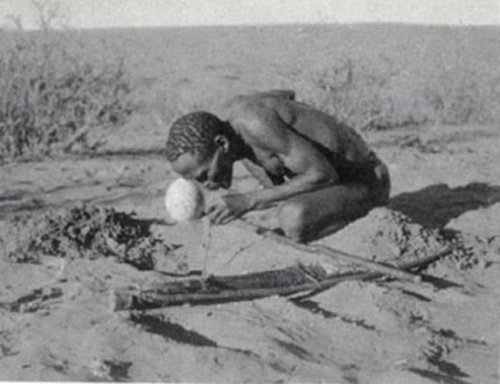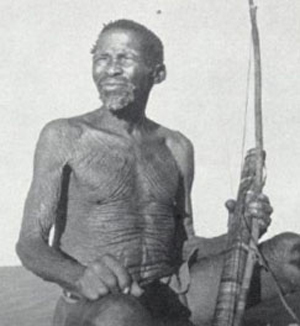Roger Pearson (anthropologist)by Wikipedia
Accessed: 6/26/20
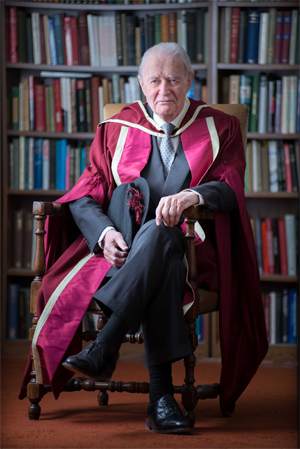 Roger Pearson (born 21 August 1927 in London) is a British anthropologist, soldier, businessman, eugenics advocate, political organiser for the extreme right, and publisher of political and academic journals.
Roger Pearson (born 21 August 1927 in London) is a British anthropologist, soldier, businessman, eugenics advocate, political organiser for the extreme right, and publisher of political and academic journals. He has been on the faculty of the Queens College, Charlotte, the University of Southern Mississippi, and Montana Tech, and is now retired. It has been noted that
Pearson has been surprisingly successful in combining a career in academia with political activities on the far right.[1] He served in the British Army after World War II, and was a businessman in South Asia. In the late 1950s he founded the Northern League.The Northern League was a neo-Nazi organisation founded by Roger Pearson. It was active in the United Kingdom and in northern continental Europe in the latter half of the 20th century.
Roger Pearson formed the Northern League in collaboration with Peter Huxley-Blythe, who was active in a variety of neo-Nazi groups with connections in Germany and North America. The League published the periodical The Northlander.
The stated purpose was to save the "Nordic race" from "annihilation of our kind" and to "fight for survival against forces which would mongrelize our race and civilization". The Northern League merged newsletters with Britons Publishing Company, an anti-Semitic publisher and a major distributor of the Protocols of the Elders of Zion.Leading members of the Northern League included the Nazi racial eugenicist Hans F. K. Günther, who continued his work in the post-war period under a pseudonym. Other active members included the founder of
Mankind Quarterly,
Robert Gayre, and its editors Robert E. Kuttner and Donald A. Swan; the American segregationist Earnest Sevier Cox, the ex–Waffen SS officer and post-war neo-Nazi leader Arthur Ehrhardt, and a number of post-war British fascists, though even among fascists, the Northern League was considered extremist. Among its co-founders and activists were Alastair Harper, the United Kingdom Independence Party (UKIP) parliamentary candidate in Dunfermline West in 2001.
Northern League literature was written in the style of scientific racism (e.g., the work of Pearson's collaborator Raymond B. Cattell) and its Statement of Aims reflects 19th century conceptions of Rasse and Volk. Andrew S. Winston of the University of Guelph writes in an analysis of this group:
"According to the 'Aims', Northern Europeans are the 'purest survival of the great Indo-European family of nations, sometimes described as the Caucasian race and at other times as the Aryan race'. Almost all the 'classic civilisations of the past were the product of these Indo-European peoples'. Intermarriage with conquered peoples was said to produce the decay of these civilizations, particularly through interbreeding with slaves. 'The rising tide of Color"' threatens to overwhelm European society, and would result in the 'biological annihilation of the subspecies', according to the Northern League."
-- Northern League (United Kingdom), by Wikipedia
In the 1960s he established himself in the United States for a while working together with Willis Carto publishing white supremacist and anti-Semitic literature.[2]
Willis Allison Carto (July 17, 1926 – October 26, 2015) was an American far right political activist. He described himself as Jeffersonian and populist, but was primarily known for his promotion of antisemitic conspiracy theories and Holocaust denial.
Carto was known as a political racial theorist through the Liberty Lobby and successor organizations which he helped create. Carto ran a group supporting segregationist George Wallace's 1968 presidential campaign which formed the basis for the National Youth Alliance which promoted Francis Parker Yockey's political philosophy. Carto helped found the Populist Party, which served as an electoral vehicle for white supremacist group and Ku Klux Klan members, such as David Duke in the 1988 presidential election and Christian Identity supporter Bo Gritz in 1992. Carto ran the American Free Press newspaper which publishes anti-semitic and racist books and features columns by Joe Sobran, James Traficant, Paul Craig Roberts, and others. The organization promotes 9/11 conspiracy theories. Carto's many other projects included the Institute for Historical Review, which promotes Holocaust denial.
-- Willis Carto, by Wikipedia
Pearson's anthropological work is based in the eugenic belief that "favorable" genes can be identified and segregated from "unfavorable" ones. He advocates a belief in biological racialism, and claims that human races can be ranked.[3][4] Pearson argues that the future of the human species depends on political and scientific steps to replace the "genetic formulae" and populations that he considers to be inferior with ones he considers to be superior.[5][6][7][8]
Pearson also published two popular textbooks in anthropology, but his anthropological views on race have been widely rejected as unsupported by contemporary anthropology. In 1976 he found the Journal of Social, Political and Economic Studies, which has been identified as one of two international journals which regularly publishes articles pertaining to race and intelligence with the goal of supporting the idea that white people are inherently superior (the other such journal being Mankind Quarterly).[9] In 1978 he took over the editorship of Mankind Quarterly founded by Robert Gayre and Henry Garrett, widely considered a scientific racist journal. Most of Pearson's publishing ventures have been managed through the Institute for the Study of Man, and the Pioneer Fund, with which Pearson is closely associated, having received $568,000 in the period from 1981-1991.[10][11][12]
Pearson's opposition to egalitarianism extends to Marxism and socialism. In the 1980s, he was a political organizer for the American far-right; he established the Council for American Affairs and was the American representative in the World Anti-Communist League. As World Chairman of the WACL he worked with the U.S. government during the cold war, and he collaborated with many anti-communist groups in the organisation, including the Unification Church and former German Nazis.[13][14]On his website, Pearson disputes specific accusations of race-hate, of anti-semitism, of arguing in favor of genocide, involuntary eugenics, forced repatriation of legal immigrants, subjugation or exploitation by one group of another, extreme or fascist politics—including National Socialism or any totalitarian system—as well as denying accusations of impropriety.[15]
Early lifeRoger Pearson was born on 21 August 1927 in London.[16][17] He grew up in England during World War II and his only sibling, a Battle of Britain fighter pilot (238 Squadron), four of his cousins (three pilots/aircrew) and two school friends died in that war. Later, Pearson would frequently describe World War II as a senseless "fratricidal war", in which the mutual destruction of Germanic peoples contributed to the gradual downfall of the Nordic race.[18]
Pearson joined the British Army's Queen's Royal Regiment in April 1945 in England, and was commissioned in 1946 from the British Indian Army's Officers Training School Kakul, North-West Frontier Province (today the Pakistan Military Academy). He served with the British Indian Army in Meerut, (1946) before the Partition of India, with the British Indian Division in the Occupation of Japan, and with the British Army in Singapore (1948), before returning to university in England. Pearson later directed various British-controlled companies in East Pakistan (now Bangladesh).
From the University of London, he gained a master's degree in economics and sociology and a PhD in anthropology.[19]
Early political engagementIn 1958 he founded the Northern League for North European Friendship, an organisation promoting Pan-Germanism, Anti-semitism and Neo-Nazi racial ideology.[20][21][22] The Northern League published the journals "The Northlander" and "Northern World" which described its purpose as "to make Whites aware of their forgotten racial heritage, and cut through the Judaic fog of lies about our origin and the accomplishments of our race and our Western culture."[23] In 1959 in the Northlander, Pearson described the aim of the organization as preventing the "annihilation of our kind" and to lead Nordics in Europe and the Americas in the "fight for survival against forces which would mongrelize our race and civilization"[24] He also wrote of the need for "a totalitarian state, with conscious purpose and central control . . . to embark upon a thorough-going policy of genetic change for its population. . . . [T]here is surely little doubt that it could soon outstrip rival nations."[25] Under the pen name Edward Langford,[16] Pearson also wrote a series on "Authors of Human Science" with portraits of prominent racialists such as Arthur de Gobineau, Houston Stewart Chamberlain,[26] Arthur Keith,[27] Madison Grant[28] and Lothrop Stoddard.[29]
Pearson also corresponded with American segregationist Earnest Sevier Cox, a dedicated member of the League, who had lobbied for a federal funding to "Repatriate" African-Americans to Africa since the 1920s. Pearson assured him that "I am entirely with you on your efforts to obtain Federal aid to American Negroes who wish to return to Africa."[25]
From the beginning the League was criticized because of its open emphasis on the dysgenic and fratricidal nature of intra-European warfare, and its tendency to attract prominent ex-Nazis such as scholar Hans F. K. Günther, who received awards under the National Socialist regime for his work on race, and Heinrich Himmler's former assistant Franz Altheim, both of whom were members of the league in its early years. Other members of the league were British Neo-Nazi Colin Jordan, and John Tyndall.[30] Pearson resigned from the League in 1961, after which it became more politically oriented.[20]
It was Cox who suggested to Pearson that they should hold a meeting at Detmold, West Germany, near what was then believed to be the site where the Germanic tribes defeated the Romans in the Battle of the Teutoburg Forest. The first meeting of the League was indeed held there in 1959, with Cox and Hans F. K. Günther as keynote speakers, although Günther's participation, him being a prominent former Nazi, had to be kept low profile.[25] The event was described by locals as "National Socialism revived".[31]
On his website, Pearson states that the Northern League never advocated National Socialism or political totalitarianism, and that membership was open to anyone who wished to receive the league's publications.[15]
Anthropological viewsPearson's anthropological views drew on the theories of British anthropologist Sir Arthur Keith, who had argued that human races were distinct evolutionary units destined to compete for resources. Pearson's early writings directly cited Keith as a major influence even while recognizing that "many will see [Keith’s observations] as a defence of Hitlerite philosophy."[32] Pearson summarizes Keith's racial and evolutionary philosophy in the following manner: "If a nation with a more advanced, more specialised, or in any way superior set of genes mingles with, instead of exterminating, an inferior tribe, then it commits racial suicide, and destroys the work of thousands of years of biological isolation and natural selection."[33]
In his work, Pearson describes racial types as subspecies, which he defines as "a distinctive group of individuals which are on their way to becoming separate species, but which have not been isolated long enough, or had time to become sufficiently diversified to lose the power to inter-breed". He argues that mixing between subspecies is detrimental as one subspecies will always be better suited for life than the other, and will therefore tend to avoid miscegenation.[24][34][35][36][37]
In 1995 and 1996 Pearson published a trilogy of articles in Mankind Quarterly regarding the "Concept of heredity in Western thought", a defense of hereditarianism and a denouncement of the "onslaught of egalitarianism". Pearson here repeated his defense for the view of racial groups as subspecies and he repeated his dedication to eugenicist ideas, although with the caveat that negative eugenics ought to take place as a voluntary act of altruistic sacrifice for one's species.[38] The same views were repeated in the 1996 book Heredity and Humanity: Race, Eugenics and Modern Science.[39]
Business in South AsiaPearson served as president of the Pakistan Tea Association, Chittagong, in 1963.[40] He also served on the managing committee of the Federation of Pakistan Chambers of Commerce and Industry.[41] Pearson sold his business interests in East Pakistan in 1965 and moved to the United States. It was during his time in South Asia that he became interested in Aryanism, and the linguistic, cultural, and genetic connections between Northern Europe and the Indo-Aryan populations of the Subcontinent.[42]
Academic career in the USRecently arrived in the United States, Pearson contributed to some of publications of anti-semite Willis Carto such as Western Destiny and to Noontide Press.[43] From 1966 to 1967 as "Stephan Langton", Pearson published The New Patriot, a magazine devoted to "a responsible but penetrating inquiry into every aspect of the Jewish Question."[44] As Lanton he published articles such as "Zionists and the Plot Against South Africa," "Early Jews and the Rise of Jewish Money Power" and "Swindlers of the Crematoria."[45] His books of this era, all published in 1966 in London by Clair Press, including Eugenics and Race, Blood groups and Race, Race & Civilisation and Early Civilizations of the Nordic Peoples were later distributed in the United States by The Thunderbolt Inc.,[46] an organ of the National States' Rights Party. Pearson's co-founder of The New Patriot was Senator Jack Tenney, who for sixteen years was Chairman of the California Senate Committee on Un-American Activities and who wrote frequently for that journal.[citation needed] Pearson joined the Eugenics Society in 1963 and became a fellow in 1977.
In 1978 he took over the editorship of the journal Mankind Quarterly, which had originally been founded in 1960 by Robert Gayre, Henry Garrett, Corrado Gini, Ottmar von Verschuer and Reginald Ruggles Gates.[47][48]
In 1973 Pearson also founded the academic Journal of Indo-European Studies.
In 1966 he toured the southern US and Caribbean, and in 1967 he visited South Africa, Rhodesia and Mozambique, before joining the faculty of the University of Southern Mississippi (USM) in 1968 as an Assistant Professor of Sociology. In 1970, he was appointed Associate Professor and head of Sociology and Anthropology at Queens College, Charlotte (now Queens University of Charlotte) but resigned to return to USM the next year as Professor and Chairman of a new Department of Anthropology, offering both bachelor's and master's degrees.[15]
In 1971 he was appointed chair of the department of Anthropology Comparative Religious Studies at the USM.[49] According to William Tucker's description, he fired most of the non-tenured faculty, hiring instead scholars such as Robert E. Kuttner and Donald A. Swan, both with similar political backgrounds to Pearson. The dean at USM later stated that Pearson had "used his post as an academic façade to bring in equal-minded fanatics."[50] Pearson himself states that this is untrue and that "It is true that two faculty members from the formerly separate Religion department, which had recently been merged with Pearson’s department to create a larger, combined department of Anthropology, Philosophy and Religion, were terminated, but this act was ordered by the Administration and not by the department Chair, Pearson."[15]
In 1974 Pearson was appointed Professor and Dean of Academic Affairs and Director of Research at Montana Tech.[51] During his tenure as dean, the school received $60,000 from the Pioneer Fund to support Pearson's academic research and publishing activities.[51] When a journalist called the various universities at which Pearson had held positions, Montana Tech officials stated they were unaware that Pearson was the person who had edited Western Destiny, a periodical laden with many pro-South Africa, anti-Communist and anti-racial mixing articles, who had penned both articles and pamphlets for Willis Carto's Noontide Press.[51] These race-oriented titles included: "Eugenics and Race" and "Early Civilizations of the Nordic Peoples."[51]
Pearson's work in publishing the work of "scholars who are supportive of a free enterprise economy, and a firm and consistent foreign policy and a strong national defense" was commended by President Ronald Reagan for his "substantial contribution to promoting and upholding those ideals and principles that we value at home and abroad."[20][52]
World Anti-Communist LeagueIn 1975, Pearson left academia and moved to Washington, D.C., to become president of the Council on American Affairs, President of the American chapter of the World Anti-Communist League, Editor of the Journal on American Affairs (later renamed The Journal of Social, Political and Economic Studies), and eventually President of University Professors for Academic Order (UPAO), an organisation advocating academic integrity, social order and that the university should not be "an instrument of social change" and working to depoliticize campus environments. He was also a Trustee of the Benjamin Franklin University.
He also served on editorial board of the several institutions, including the Heritage Foundation, the Foreign Policy Research Institute, and the American Security Council, and that a number of conservative politicians wrote articles for Pearson's Journal on American Affairs and related Monographs, including Senators Jake Garn (R-UT), Carl T. Curtis (R-NE), Jesse Helms (R-NC), and Representatives Jack Kemp (R-NY), and Philip Crane (R-UT).[43]
Pearson was elected World Chairman of the World Anti-Communist League in 1978. According to William H. Tucker he "used this opportunity to fill the WACL with European Nazis – ex-officials of the Third Reich and Nazi collaborators from other countries during the war as well as new adherents to the cause—in what one journalist called 'one of the greatest fascist blocs in postwar Europe'."[53]
Pearson presided over the League's 11th Annual Conference held in Washington that year. The initial session of the five-day session, which was addressed by two U.S. Senators and opened by the United States Marine Corps Band and Joint Armed Services Honor Guard, was attended by several hundred members from around the world. After the meeting had been condemned in Pravda, The Washington Post published an even more critical attack on both WACL and Pearson's extreme right wing politics.[54][55]
Pearson resigned from the WACL in the wake of accusations that he "encouraged the membership of European and Latin American groups with Nazi or neo-Nazi ties".[56] In a Wall Street Journal article subsequent chairman John Singlaub was quoted calling Pearson an "embarrassment" who is "not at all welcome in any activity"[56] The same article claimed that Pearson's Presidential commendation had been achieved only through the mediation of an associate of Pearson's who worked in the Defense Department. The White House did not retract the letter, but made a public statement in which the Presidential secretary affirmed the Presidents' repudiation of any sort of racial discrimination. Pearson was requested to stop using the letter from Reagan in public promotion of his activities.[56] One member of the WACL, conservative politician Geoffrey Stewart-Smith described the organization during its period under Pearson as "largely a collection of Nazis, Fascists, anti-Semites, sellers of forgeries, vicious racialists, and corrupt self-seekers."[57]
After the Washington Post article, Pearson was asked to resign from the editorial board of the neo-Conservative Heritage Foundation's journal Policy Review, which he had helped to found, but his connection with other organisations continued, and in 1986 CovertAction Quarterly uncovered his association with James Jesus Angleton, former chief of CIA Counter-Intelligence, General Daniel O. Graham, former Director of the Defense Intelligence Agency, General Robert C. Richardson, and other American Security Council members.[58]
Association with the Pioneer FundIn 1981, Pearson received the library of Donald A. Swan through a grant from the Pioneer Fund.[59] Between 1973 and 1999 the Fund spent $1.2 million on Pearson's activities, most of which was used for the Institute for the Study of Man[60] which Pearson directed and which under Pearson acquired the peer-reviewed journal Mankind Quarterly in 1979. Pearson took over as publisher and is said to have editorial influence, although his name has never appeared on the masthead. Pearson has used diverse pseudonyms to contribute to the journal, including "J. W. Jamieson" and "Alan McGregor", sometimes even using one pseudonym to review and praise the work of another.[61] This publication was later taken over by The Council for Social and Economic Studies.
Pearson is also director of the Council for Social and Economics Studies, which owns the Scott-Townsend Publishers imprint (which has published most of his recent books), and General Editor of the Journal of Social, Political, and Economic Studies.
Publications• Eastern Interlude. Thacker Spink, Calcutta; Luzac and Co., London, 1953.
• Eugenics and Race. Clair Press, London, 1958; 2nd ed. 1966, Clair Press, London and Noontide Press, Los Angeles OCLC 9737954
• Blood groups and race. (1st edition unknown) 2nd ed. 1966, Clair Press, London, and Noontide Press, Los Angeles OCLC 6099970
• Race & civilisation. (1st edition unknown) 2nd ed. 1966, Clair Press, London, and Noontide Press, Los Angeles OCLC 4387181
• Early Civilizations of the Nordic Peoples. Northern World, London, 1958. Noontide Press, Los Angeles, 1965 OCLC 9972221
• Introduction to Anthropology: an ecological/evolutionary approach. Holt Rinehart and Winston, New York, 1974.
• Sino-Soviet Intervention in Africa. Council on American Affairs, 1977.
• Korea in the World Today. Council on American Affairs, Washington, D.C., 1978.
• Ecology and Evolution. Mankind Quarterly Monograph, Washington, D.C., 1981.
• Essays in Medical Anthropology, Scott-Townsend Publishers, Washington, D.C., 1981.
• Anthropological Glossary. Krieger Publishing Co., Malabar, Fl. 1985.
• Evolution, Creative Intelligence, and Intergroup Competition. Cliveden Press, 1986
• William Shockley: Shockley on Eugenics and Race: The Application of Science to the Solution of Human Problems. Preface by Arthur Jensen. Scott-Townsend Publishers, Washington, D.C., 1992. OCLC 26400159
• Race, Intelligence and Bias in Academe. Introduction by Hans Eysenck.[46] Scott-Townsend Publishers, Washington, D.C., 1991 OCLC 25308868 (2nd. Ed. 1994).
• Heredity and Humanity: Race, Eugenics and Modern Science, 1996. Scott-Townsend Publishers, Washington, D.C., 1991 (2nd edition 1998).
References1. "Pearson has succeeded in combining such right-wing politics with a conventional academic career." – Kühl, Stefan (2001). The Nazi Connection: Eugenics, American Racism, and German National Socialism. Oxford University Press, p. 4.
2. Winston, A. S. (1996). The context of correctness: A comment on Rushton. Journal of Social Distress and the Homeless, 5(2), 231-250.
3. "Evolution cannot occur unless 'favorable' genes are segregated out from amongst 'unfavorable" genetic formulae' [...] any population that adopts a perverted or dysgenic form of altruism – one which encourages a breeding community to breed disproportionately those of its members who are genetically handicapped rather than from those who are genetically favored, or which aids rival breeding populations to expand while restricting its own birthrate – is unlikely to survive into the definite future." – Pearson, Roger (1995b). "The Concept of Heredity in Western Thought: Part Three, the Revival of Interest in Genetics," The Mankind Quarterly, 36, pp. 96, 98."
4. Pearson, Roger (1966). Eugenics and Race. London: Clair Press, p. 33.
5. Kohn, M. (1995). The race gallery: The return of racial science. London: Jonathan Cape. pp. 52-54
6. Tucker, W. H. (2002). Closer Look at the Pioneer Fund: Response to Rushton, A. Alb. L. Rev., 66, 1145.
7. Tucker, W. H. (2003). The Leading Academic Racists of the Twentieth Century. Journal of Blacks in Higher Education, 90-95.
8. Shared Eugenic Visions: Raymond B. Cattell and Roger Pearson. Andrew S. Winston, University of Guelph "Archived copy". Archived from the original on 18 August 2015. Retrieved 25 June 2015.
9. Stavenhagen, Rodolfo (14 December 2012). Pioneer on Indigenous Rights. Springer Science & Business Media. p. 90. ISBN 9783642341502.
10. "ROGER PEARSON" ISAR
11. Rosenthal, S. J. (1995). The Pioneer Fund Financier of Fascist Research. American Behavioral Scientist, 39(1), 44-61.
12. Winston, A. S. (1998). Science in the service of the far right: Henry E. Garrett, the IAAEE, and the Liberty Lobby. Journal of Social Issues, 54(1), 179-210.
13. Kuhl, S. (1994). The Nazi connection: eugenics, American racism, and German national socialism. Oxford University Press.
14. Jackson, J. P. (2006). Argumentum ad hominem in the science of race. Argumentation and Advocacy, 43(1), 14.
15. Pearson, Roger. "Derogations, Conspiracy Theories and General Inaccuracies". Retrieved 27 November 2014.
16. "ISAR - In the Circuit Court".
http://www.ferris-pages.org. Retrieved 19 June 2020.
17.
http://www.professor-roger-pearson.com/18. Tucker 2002:160
19. Paul W. Valentine (28 May 1978). "The Fascist Specter Behind The World Anti-Red League". The Washington Post.
20. Russ Bellant (1991). Old Nazis, the new right, and the Republican Party (3rd ed.). Boston: South End Press. OCLC 716423118.
21. Steven J. Rosenthal (September 1995). "The Pioneer Fund: Financier of Fascist Research". American Behavioral Scientist. 39 (1): 44–61. doi:10.1177/0002764295039001006.
22.
http://www.psychology.uoguelph.ca/facul ... shton.html23. Lincoln, Bruce (1999). Theorizing Myth: Narrative, Ideology, and Scholarship. University of Chicago Press, p. 122.
24. A. S. Winston. (1996). The context of correctness: A comment on Rushton. Journal of Social Distress and the Homeless, 5, 231—250. "Pearson was clear about the problem of contact between races: ". . . evolutionary progress can only take place properly amongst small non-cross-breeding groups. Always, a cross between two types meant the annihilation of the better type, for although the lower sub-species would be improved by such a cross, the more advanced would be retarded, and would then have a weaker chance in the harsh and entirely amoral competition for survival." (1959a, pp. 9-10)[1]
25. Jackson, John P. (2005). Science for Segregation: Race, Law, and the Case against Brown v. Board of Education. NYU Press. ISBN 978-0-8147-4271-6. pp.43–144
26. Langford, Edward, 1958. Northlander vol 1 no 3
27. Langford, Edward, 1958. Northlander vol 1 no 5
28. Langford, Edward, 1958. Northlander vol 1 no 6
29. Langford, Edward, 1958. Northlander vol 1 no 7
30. Tucker 2002:161-3
31. Anderson, Scott, & Anderson, Jon Lee (1986). Inside the League: the Shocking Exposé of how Terrorists, Nazis, and Latin American Death Squads have infiltrated the world Anti-Communist League. New York: Dodd, Mead, p. 94.
32. Pearson, Roger. 1957. "Sir Arthur Keith and Evolution." Northern World 2, no. 1 (1957): 4– 7. cited in Jackson, J. P. (2005). Science for segregation: Race, law, and the case against Brown v. Board of Education. New York: New York University Press. p 46
33. Pearson, Roger. 1966 [1959]. Eugenics and Race. p. 26
34. Pearson, R. 1966 [1959]. Blood groups and race. London: Clair Press.
35. Pearson, R. (1959). Eugenics and race London: Clair Press.
36. Pearson "Eugenics and Race" "There is no way of eliminating undesirable genetic qualities except by annihilating the 'line,' that is by preventing the individual who carries the unfortunate genes from reproducing at all. If one does not wish to go so far as that then one must at least prevent cross-breeding between 'healthy and unhealthy stock, for once the entire stock is contaminated there is no solution other than the annihilation of the entire species." p. 27
37. Pearson, 1966 [1959] "Eugenics and Race" pp. 40-41 "To think and practice eugenic and racial morals ourself is our duty, but this is not enough in the troubled state of the world today. It is necessary for each and every one of us to work to bring these ideas home to our fellow beings. We must talk and write about eugenics and race; we must help to make the ideas "fashionable" as quickly as we can. Let there be no confusion, also, between the two concepts for basically they are one and the same. A race is a group of individuals who possess a similar genetic heritage, and who when crossed are capable of breeding true. A race is consequently pure or impure according to its ability to breed true, and to produce its own kind. Biological accidents do occur, and these may result in the defects which eugenics seeks to remove from the mainstream (not necessarily by inhumane means), but differences in emotive, intellectual and physical constitution, where not acquired, are largely racial, the product of the importation of a different pattern of genes. ... We can only prevent the destruction of this edifice if we take it upon ourselves to overcome our• inherent shyness of such topics, to forget that we might possibly say something that might offend our neighbours, and start talking about race, racial hygiene and human eugenics. Only thus can we ensure that our children and-their children-will be able to find fitting partners for marriage. Only thus can we ensure the survival of our own kind and our own species and also lay the foundations for a noble future. Human stock-breeding is surely not a bad thing when exercised voluntarily and intelligently, and when its aim is to preserve an aristocracy of mankind."
38. Pearson, R. (1995). The concept of heredity in Western thought. III: The revival of interest in genetics. Mankind quarterly, 36(1), 73-103. "Once science can determine which individuals and populations have disproportionately high gene frequencies for advantageous traits, and which are handicapped by deleterious genetic qualities, societies which are prompted by a higher altruism dedicated to the wellbeing of future generations, rather to the sole gratification of the selfish needs of those who are currently living, will be able to effectively select eugenic over dysgenic reproduction. If true altruism prevails, the result will be eugenic decisions, made voluntarily and without coercion." "Any species that adopts patterns of behavior that run counter to the forces that govern the universe is doomed to suffer a painful, harshly enforced and totally involuntary eugenic process of evolutionary reselection and readaptation - or an even more severe penalty, extinction."
39. Timson, John. 1998. Review: Heredity and Humanity: Race, Eugenics and Modern Science. [2]Archived 24 September 2015 at the Wayback Machine
40. "Pakistan Tea Association chairman's Speech." Eastern Examiner, Dacca, 30 April 1963.
41. Pakistan Tea Association Annual Report
42. Zeskind, Leonard (2009). Blood and Politics: The History of the White Nationalist Movement from the Margins to the Mainstream. Macmillan, p. 12.
43. Michael, George (2008). Willis Carto and the American Far Right. University Press of Florida.
44. Heidi Beirich (2008), "Of Race and Rockets", Intelligence Report, Southern Poverty Law Center (130)
45.
http://www.splcenter.org/get-informed/i ... oneer-fund46. Bruce Lincoln (2000). Theorizing Myth: Narrative, Ideology, and Scholarship. University of Chicago Press. p. 259. ISBN 978-0-226-48202-6.
47. Schaffer, Gavin "‘Scientific’ Racism Again?":1 Reginald Gates, the Mankind Quarterly and the Question of "Race" in Science after the Second World War Journal of American Studies (2007), 41: 253-278 Cambridge University Press
48. Jackson, John P. (2005). Science for Segregation: Race, Law, and the Case against Brown v. Board of Education. NYU Press. ISBN 978-0-8147-4271-6. Lay summary (30 August 2010).
49. Macklin, Graham (2012). "Transatlantic Connections and Conspiracies: A.K. Chesterton and The New Unhappy Lords". Journal of Contemporary History. 47 (2): 270–290. doi:10.1177/0022009411431723. ISSN 0022-0094.
50. Tucker 2002:166-67
51. Lichtenstein, Grace (11 December 1977). "Fund Backs Controversial Study of 'Racial Betterment'". New York Times.
52. Zeskind (2009), p. 12-13.
53. Tucker, William H. (Reissue 1996). The Science and Politics of Racial Research. University of Illinois Press. p. 257. ISBN 978-0252065606. Check date values in: |year= (help)
54. Paul W. Valentine, "The Fascist Specter Behind The World Anti-Red League". The Washington Post. 28 May 1978
55. Tim Kelsey; Trevor Rowe (4 March 1990). "Academics were funded by racist American trust". The Independent.
56. Rich Jaroslovsky (28 September 1984). Politics '84 -- Controversial Publisher: Racial Purist Uses Reagan Plug. Wall Street Journal (Eastern Edition), p. 1. Retrieved 6 November 2007, from ABI/INFORM Global database. (Document ID: 27121258).[3]
57. McManus, Doyle (16 September 1985). "Rightist Crusade Finds Its Way Into Spotlight: Led by Retired Gen. Singlaub, Anti-Communist League Is Funnel for Private Funds to Contras" (fee required). Los Angeles Times. Retrieved 8 October 2008.
58. "The Checkered Careers of James Angleton and Roger Pearson", Covert Action, No. 25 (Winter 1986)
59. Miller, Adam (Winter 1994–1995). "The Pioneer Fund: Bankrolling the Professors of Hate". The Journal of Blacks in Higher Education (6): 58–61, 60–61. JSTOR 2962466. OCLC 486658694.
60. Tucker, William H. (2002). The Funding of Scientific Racism: Wickliffe Draper and the Pioneer Fund. University of Illinois Press. p. 170. ISBN 978-0252027628.
61. Tucker, William H. (2007). The Funding of Scientific Racism: Wickliffe Draper and the Pioneer Fund. University of Illinois Press. ISBN 978-0-252-07463-9. Lay summary (4 September 2010).
• Russ Bellant, The Coors Connection (South End Press, 1989), p. 2; John Saloma, Ominous Politics (NY: Hill & Wang, 1984), p. 8.
• Bellant, Russ (1991). Old Nazis, the New Right, and the Republican Party. Boston: South End Press.
• Harris, Geoffrey (1994). The Dark Side of Europe: The Extreme Right Today. Edinburgh University Press.
External links• Pearson's personal website with additional biographic information and photos
• Works by Roger Pearson, at Unz.org
• Mankind Quarterly
• Journal of Social, Political, and Economic Studies
• Shared Eugenic Visions: Raymond B. Cattell and Roger Pearson
